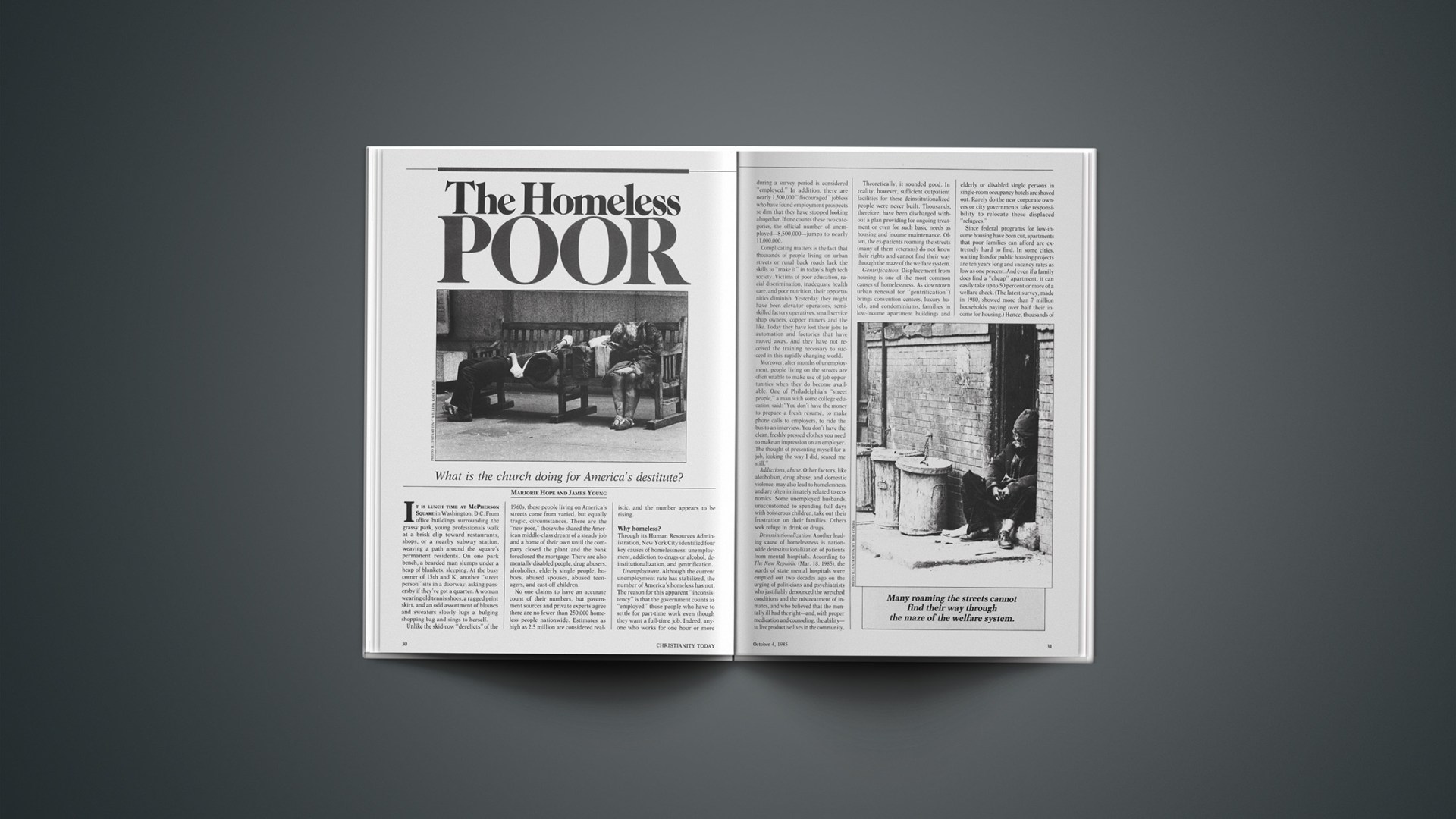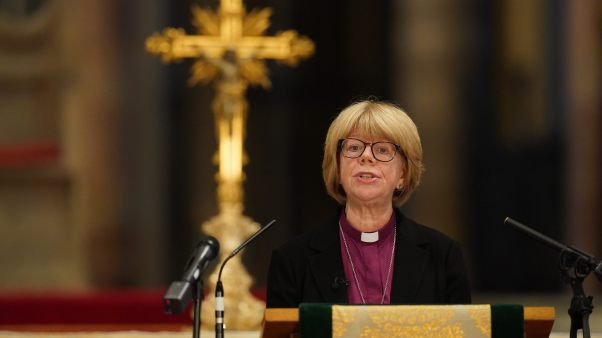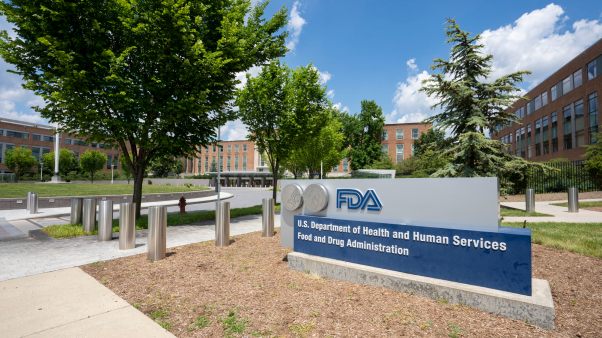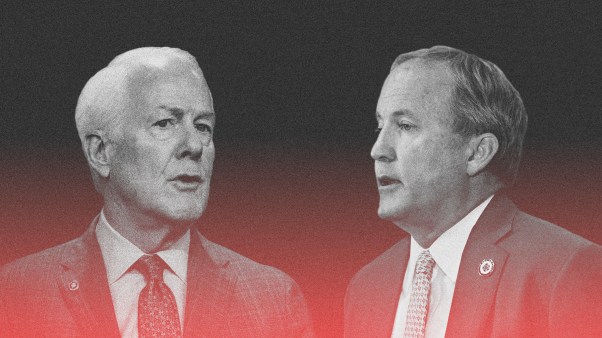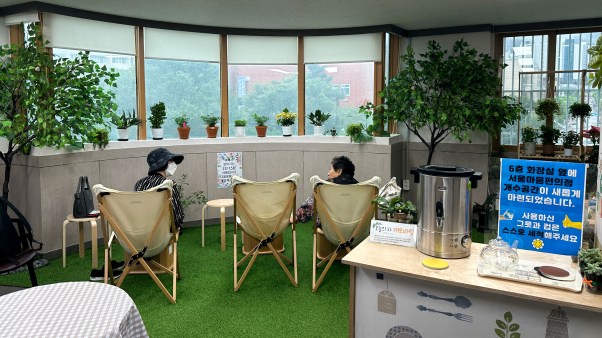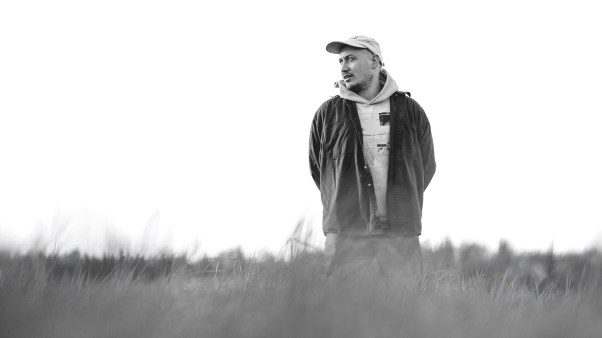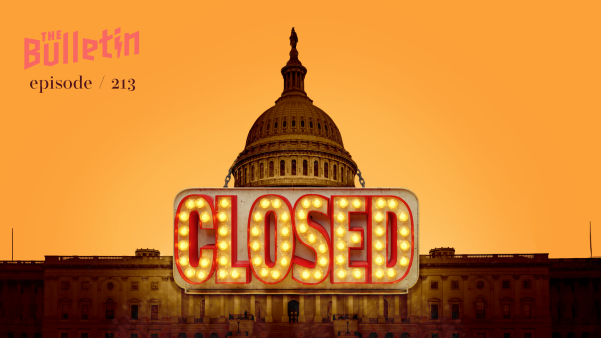It is lunch time at McPherson Square in Washington, D.C. From office buildings surrounding the grassy park, young professionals walk at a brisk clip toward restaurants, shops, or a nearby subway station, weaving a path around the square’s permanent residents. On one park bench, a bearded man slumps under a heap of blankets, sleeping. At the busy corner of 15th and K, another “street person” sits in a doorway, asking passersby if they’ve got a quarter. A woman wearing old tennis shoes, a ragged print skirt, and an odd assortment of blouses and sweaters slowly lugs a bulging shopping bag and sings to herself.
Unlike the skid-row “derelicts” of the 1960s, these people living on America’s streets come from varied, but equally tragic, circumstances. There are the “new poor,” those who shared the American middle-class dream of a steady job and a home of their own until the company closed the plant and the bank foreclosed the mortgage. There are also mentally disabled people, drug abusers, alcoholics, elderly single people, hoboes, abused spouses, abused teenagers, and cast-off children.
No one claims to have an accurate count of their numbers, but government sources and private experts agree there are no fewer than 250,000 homeless people nationwide. Estimates as high as 2.5 million are considered realistic, and the number appears to be rising.
Why Homeless?
Through its Human Resources Administration, New York City identified four key causes of homelessness: unemployment, addiction to drugs or alcohol, deinstitutionalization, and gentrification.
Unemployment. Although the current unemployment rate has stabilized, the number of America’s homeless has not. The reason for this apparent “inconsistency” is that the government counts as “employed” those people who have to settle for part-time work even though they want a full-time job. Indeed, anyone who works for one hour or more during a survey period is considered “employed.” In addition, there are nearly 1,500,000 “discouraged” jobless who have found employment prospects so dim that they have stopped looking altogether. If one counts these two categories, the official number of unemployed—8,500,000—jumps to nearly 11,000,000.
Complicating matters is the fact that thousands of people living on urban streets or rural back roads lack the skills to “make it” in today’s high tech society. Victims of poor education, racial discrimination, inadequate health care, and poor nutrition, their opportunities diminish. Yesterday they might have been elevator operators, semi-skilled factory operatives, small service shop owners, copper miners and the like. Today they have lost their jobs to automation and factories that have moved away. And they have not received the training necessary to succeed in this rapidly changing world.
Moreover, after months of unemployment, people living on the streets are often unable to make use of job opportunities when they do become available. One of Philadelphia’s “street people,” a man with some college education, said: “You don’t have the money to prepare a fresh résumé, to make phone calls to employers, to ride the bus to an interview. You don’t have the clean, freshly pressed clothes you need to make an impression on an employer. The thought of presenting myself for a job, looking the way I did, scared me stiff.”
Addictions, abuse. Other factors, like alcoholism, drug abuse, and domestic violence, may also lead to homelessness, and are often intimately related to economics. Some unemployed husbands, unaccustomed to spending full days with boisterous children, take out their frustration on their families. Others seek refuge in drink or drugs.
Deinstitutionalization. Another leading cause of homelessness is nationwide deinstitutionalization of patients from mental hospitals. According to The New Republic (Mar. 18, 1985), the wards of state mental hospitals were emptied out two decades ago on the urging of politicians and psychiatrists who justifiably denounced the wretched conditions and the mistreatment of inmates, and who believed that the mentally ill had the right—and, with proper medication and counseling, the ability—to live productive lives in the community.
Theoretically, it sounded good. In reality, however, sufficient outpatient facilities for these deinstitutionalized people were never built. Thousands, therefore, have been discharged without a plan providing for ongoing treatment or even for such basic needs as housing and income maintenance. Often, the ex-patients roaming the streets (many of them veterans) do not know their rights and cannot find their way through the maze of the welfare system.
Gentrification. Displacement from housing is one of the most common causes of homelessness. As downtown urban renewal (or “gentrification”) brings convention centers, luxury hotels, and condominiums, families in low-income apartment buildings and elderly or disabled single persons in single-room occupancy hotels are shoved out. Rarely do the new corporate owners or city governments take responsibility to relocate these displaced “refugees.”
Since federal programs for low-income housing have been cut, apartments that poor families can afford are extremely hard to find. In some cities, waiting lists for public housing projects are ten years long and vacancy rates as low as one percent. And even if a family does find a “cheap” apartment, it can easily take up to 50 percent or more of a welfare check. (The latest survey, made in 1980, showed more than 7 million households paying over half their income for housing.) Hence, thousands of people are being evicted for inability to pay the rent.
Loss of social benefits is still another precipitating cause of homelessness. Many mentally and physically disabled persons who once qualified for social security disability or Supplemental Security Income (SSI) have been dropped from the rolls.
Life On The Streets
It is not hard to find out what life is like for these people. On streets, under bridges, beside boxcars, and in shelters, parks, Traveler’s Aid offices, and dilapidated autos, the homeless respond quickly (and with surprise) to expressions of genuine interest in their lives.
So varied are their backgrounds and experiences that it is difficult to make generalizations. Yet there are a few common threads. Many fear freezing to death. Others fear the police: in some communities they treat “those bums” roughly. Women and the elderly often fear younger men who take out their anger with the world on people who are even more powerless than themselves.
Frustration and despair are commonplace, the result of hunting for an unpoliced spot to sleep, standing for hours in soup lines, or waiting long hours at some welfare office (only to be told that still another paper needs to be brought). After a few weeks they lose faith in the future—and in themselves. As one man put it, “I began to see myself the way others saw me. I thought there was something wrong with me. After a while, I couldn’t look people in the eyes.” In the end, they feel forsaken.
Volunteer Friends
It is largely through the efforts of Christian groups that today there are hundreds of public and private shelters across the United States for these wanderers. A few congregations have opened their church basements as shelters. More often they use other church property or raise funds to rent or buy a building in the neighborhood. Most of the “public” shelters in the United States are actually run by voluntary private groups, either lay organizations like Traveler’s Aid, or church-affiliated ones. City governments usually prefer to contract with such groups because they almost always do a better job in operating these shelters. In the words of a minister’s wife who directs a day center for homeless women, “The church brings a dimension of compassion and caring, which you find much less often among city workers to whom this is just another job.”
Although shelters by themselves do not answer the need for permanent housing, jobs, mental health treatment, or income, such facilities can offer immediate refuge and food along with a warm welcome. And volunteers can make all the difference in how welcome and wanted the guests feel.
Buddy Gray was living in one of Cincinnati’s poor areas when he began to see that many of the people “living rough” were victims of street violence or were freezing in empty buildings. He decided to put some of the men up in his own place, carrying the exhausted ones up four flights of stairs. But that was not enough. Together with a Lutheran minister and a few other concerned people, Gray helped found the Drop-Inn Center, the first open shelter in the city. Today he is coordinator of the center—but refuses to be paid.
Such volunteers are the lifeblood of support for the homeless and hungry. Since private shelters always operate on a shoestring, few can get along without these people who donate their time. At Cincinnati’s Drop-Inn Center, prison chaplain Bill Schiesl volunteers several times a week to check in people waiting in the soup line and to watch over the men sleeping on floor mats. But most of the volunteers who ladle out food in the center are lay people from the neighborhood, or from schools, colleges, and churches. Teachers say they consider it an important experience for their pupils, and clergy say the same for their congregations.
Some volunteers have joined groups that patrol the streets dispensing hot food and taking those who want refuge to nearby shelters. Others go out regularly to talk with “bag ladies” and other hard-core street people. Their goal is not so much to persuade street people to come “inside” as to form warm ongoing relationships with them.
Still other volunteers drive vans, solicit food donations, write publicity, do office work, engage in fund raising, or join the referral service at the local Community Chest or affiliate of the National Coalition for the Homeless. Today there are so many opportunities that New York, for example, has a special phone line to provide information about volunteering and donations. It rings when S-H-E-L-T-E-R is dialed.
On another level, many people have become “friends of the homeless” by attending interfaith services to memorialize men and women who have died on the streets. These “friends” report that to stand beside homeless people in a church and to walk with them in a candlelight procession can be a rare experience in human solidarity and consciousness raising.
People who have no time to volunteer can still make a difference by offering odd jobs to men and women who have suffered despair and loss of self-confidence caused by months or years of joblessness.
Professionals often donate their skills. In Seattle, nurses and nursing students check residents of the Downtown Emergency Service Center and refer those who need treatment to clinics. In Chicago, Traveler’s Aid chief Les Brown devotes evenings and weekends to presiding over the Chicago Coalition for the Homeless.
Most volunteers find that if they work through a group such as a church, their effectiveness is multiplied. In New York, more than 6,000 volunteers belonging to 130 Partnership for the Homeless faith communities cooperate in running 50 private shelters, some of which are located within houses of worship. According to founder Peter Smith, religious leaders have been astounded at the number of people in their own flocks who have offered to help. Many clergy and lay volunteers have declared that the experience revitalized their congregations.
As concerned citizens have succeeded in convincing supermarkets to donate outdated but edible food for food banks, some communities have passed “Good Samaritan” laws legalizing and encouraging the practice. Volunteers are greatly needed at day centers where the homeless come in to escape the cold, collect mail, doze, have a shower and shave, write letters, watch TV, and talk. Most day centers have meager recreation facilities. They need books, magazines, records, games, sewing materials—and most of all, helpers who can gently encourage these dispirited people to engage in some meaningful activity. After relationships between volunteers and the guests of day centers or shelters have deepened, many of the latter are moved to talk of their spiritual needs.
Knowledge of community resources is helpful, since most people in shelters want jobs, more permanent housing, legal aid, or welfare assistance. Even more important is the ability simply to listen, not with pity, but empathy.
A Place To Stay Warm
There is a great lack of transitional housing—relatively small facilities where the homeless can stay while efforts are made to assist them in getting their lives in order. One of the most successful examples is the work of the Community of Hope, a mission church of the Church of the Nazarene in Washington, D.C. Tom Nees, the community’s quietly dynamic young minister, explains the program: “We take families with the ability to survive on their own and lodge them in this apartment building. In the same building we have a large room on the first floor that is used as a church on Sunday and as a place of refuge during the week. In the back, and on other floors, there is a community health clinic, a law office, a jobs program, and a program for children and youth, all offering services to help both homeless people and residents of the neighborhood.” The apartment building was rehabilitated by the community members’ own labor. Numbering only 50, the “renters” undergo a rigorous apprenticeship in order to join.
“The city pays us for the apartment rent—about $300 a month,” says Nees. “We hold the money in escrow, and give it to the family at the end of their stay here to help them meet the costs of moving and setting up an apartment.”
The Partnership for the Homeless is working with New York City officials to make permanent housing available by placing the homeless in buildings taken over by the city from landlords who fail to pay taxes. Partnership volunteers work directly with the homeless and with skilled laborers to rehabilitate the apartments. In New York, church groups, using many volunteers, have developed apartment buildings for use by lower-income families, the handicapped, and temporarily homeless families sponsored by churches. Once the projects are completed, all “co-operators” or their sponsors will become equal shareholders in the cooperatives.
Finally, groups of concerned citizens have begun to focus local, state, and national attention toward action that can help prevent homelessness. In San Francisco, for example, they have been working to strengthen loophole-ridden laws against conversion of low-income residential hotels to high-priced tourist facilities. They have fought for reinstatement of lost welfare and disability benefits. They have joined the California Homeless Coalition, which is working both to alleviate and prevent homelessness. Recently, the coalition rallied support for state legislation appropriating $10 million for assisting shelter operators and rehabilitating residential hotels. Says Dick Park, chair of San Francisco’s Central City Shelter Network: “None of the progress made in California—or the rest of the country—would be possible without the men and women who donate their time.”
Nees urges the creation of more nonprofit corporations like the Community of Hope that can enter the housing market and purchase apartment buildings at below-market value.
Nees speaks with gratitude of his ministry. “I’m learning more about love than I thought existed. In this neighborhood I am loved by people who have every reason to dislike me for what my white skin and privilege represent. I’m learning that it is just as important to receive Christ in those who come to see me as it is to offer faith to those who will listen. As Mother Teresa reminds us: Jesus comes to us disguised as the hungry Jesus, the naked Jesus, the homeless Jesus, the imprisoned Jesus.
“Many times I’ve heard people say that if Jesus should come to our world he would most likely be found in the forgotten quarters of the city where people suffer the most. The truth of the gospel is that Jesus has come to our world. But for those of us at the Community of Hope, indeed we have found the Lord together, here.”
Off-track Evangelism
Southern Baptist pastor Eddie Hernandez lives in a blue-collar neighborhood in South Broward County, Florida, just north of Miami. He commutes to his church in affluent Pembroke Pines. But the heart of his ministry is in a poorer section of the county: Hallandale’s Gulfstream Race Track, where Hernandez is race track chaplain.
Gulfstream, one of Florida’s busiest tracks, is home to dirt-poor walkers, trainers, stable hands, and transients from around the country who winter in Florida. And while the task of counseling, feeding, and housing these people has strained the resources of Hernandez’s 125-member church, still, the congregation gave away one-fifth of its 1984 budget to help.
“I was poor,” says Hernandez, who grew up in a one-room shack. “I know what it is like to go hungry, to go without a Christmas, and to go without a family. If God delivered me from that, the least I can do is bless others. You don’t forget where you come from.”
His church, Pembroke Lakes Community Church, meets in an elementary school building and operates on an annual budget of $31,000. It runs a drug and alcohol counseling ministry at the track and hosts holiday feasts for track employees during Thanksgiving, Christmas, and Easter.
“I’m a firm believer that the church should take over the responsibilities that the government is doing,” Hernandez says. “But I get more help from non-Christians than I do Christians. I don’t get the support (in money or food) from churches that I should. Everything involved with a race track is sin to them and they won’t support it.”
Pembroke Lakes has also opened a Christian coffee house and counseling ministry in a local shopping center. “The church is not to be the sphere of my ministry,” says Hernandez. “It’s to be my base.”
Melting Steel Hearts
When unemployment around Pittsburgh reached skyscraper heights around four years ago, Saint Stephen’s, a 1,500-member evangelical congregation in the affluent suburb of Sewickley, began Help Offer People Employment (HOPE), a temporary job service for people subject to layoff and recall. In its first year alone, HOPE received 1,200 calls for food, housing, child care, and money. Work was found for 130 people, and 9 accepted permanent jobs.
Later, the church founded Job Seekers, a seven-week course for the unemployed on how to regain dignity and self-esteem. In addition to learning about résumés, networking, and how to use their talents, 15 to 20 Job Seeker clients have accepted Christ. Church spokeswoman Charlotte Morris says these are people who, had it not been for their joblessness, might have never found Christ.
“Social action is part of evangelism,” says the Epsicopal church’s rector, the Reverend John Guest. “What’s great is when Christians tackle those issues with the love of Jesus, but with secular ingenuity.” Guest helped found the Pittsburgh Leadership Foundation, which raises money for slum renovation, fights pornography, and participates in alcohol and drug rehabilitation programs. Guest is a believer in the church taking over government social service functions.
“If you could give the money to the Christian church that would ordinarily go to government agencies, we’d get 20 times the amount done,” he says. “The church is genuinely geared toward serving people. The professional social worker is not that helpful, and more money goes to the bureaucracy than to the poor themselves.”
Saint Stephen’s also gets to the root of unemployment, part of which is traceable to traditional enmities between labor and management. It supports Value of a Person, a Christian labor relations ministry based in Pittsburgh. As labor and management representatives learn to trust one another through prayer breakfasts, seminars, and prayer groups, Christians on both sides plan together how to create new industry in the depressed mill towns north of Pittsburgh.
Vignettes by Julia Duin, religion writer for The Hollywood Sun-Tattler in Hollywood, Florida.
Young, Urban, and “Professionally” Poor
Serving the poor required some downward mobility for Bob Lupton, founder of the Atlanta-based Family Consultation Services (FCS), a Christian counseling service for the poor. FCS works with Georgia Avenue Church, an unusual American Baptist/Presbyterian Church (USA) congregation of “haves” and “have-nots” in Atlanta’s poor Grant Park neighborhood.
Lupton was all set to build a home in Stone Mountain, a well-to-do suburb east of Atlanta when, as he puts it, God told him to settle in Grant Park. Lupton built his new home down the street from the church, and discovered that his building caused local property values to rise. This brought the issue of gentrification (the rich displacing the poor) to the fore, and church members and the 17-member FCS staff decided to do something about it.
Gathering contributions and donated labor from suburban churches, FCS built and sold homes for $12,000 each to poor families at no profit and at no interest. Eight families have purchased these homes, managing to afford house payments of $100 per month. FCS also took over a 20-unit apartment building, LeMadre Arms, where church members and middle-class FCS staff live side by side. The rent ranges from $225 to $275 per month, and the apartments, which come with porches and oak wood floors, are comfortable.
“A lot of evangelicals may have this myth that the poor are poor because they’re sinful, and if they’d accept the Lord, they’d get out of poverty,” says psychologist Lupton. “But Christ has taken up residence among the poor, and there are deep roots of faith here. Evangelism flows out of this as you feed, clothe, and give dignity to people in the name of the Lord.”
FCS also operates The Family Store, a shop across from the church that sells inexpensive clothes and trains community members in retail merchandising.
The church verged on closing six years ago. American Baptist pastor Chad Hale talked its owners at the Presbytery of Atlanta out of selling it. He, his copastor Richard Dalton, and Lupton have since attracted a congregation from the neighborhood.
“We’re learning from those who are poor and least in this world,” Hale says. “We’re not trying to be paternal. Although as a pastor it’s always a desire to move to greater positions of influence, I felt the need to move toward the poor.”
Wednesday Withdrawals
In King County, Washington, people who are hungry can visit 43 food banks belonging to the Northwest Harvest network. Thanks to generous media coverage and a Seattle tradition of giving to the needy ever since the Boeing layoffs in the early 1970s, the public donates $1.3 million in cash and $3 million in food to the network each year.
One of these food banks belongs to Bethany Presbyterian Church in Seattle’s Queen Anne Hill district. The traditional red brick PC(USA) church is a popular spot Wednesday nights when refugees, the mentally ill, the unemployed, the disabled, the elderly, and the lonely line up outside the converted garage. They receive a box of food with no questions asked. The food bank opened in 1980 to help feed unemployed lumbermen and fishermen, but federal cutbacks have increased the clientele from 25 to 70 families per week.
“We anticipated that things would drop back when the economy picked up,” says Bruce Devereaux, the deacon in charge of the food bank, “but people who were not making it before are slipping further and further behind.” Fifteen to 17 church members each week help Devereaux order the food, take reservations for food boxes, pick up the food from distributors, box it, and hand it out.
Bethany Presbyterian, with about 300 members, also resettles Laotian refugees in rural Woodinville, east of Seattle. The church started sponsoring Laotian refugees five years ago, but no one could find jobs for them. The Laotians, who are farmers, could not compete with the more highly educated and skilled Vietnamese. Someone deduced that the Laotians would fare better on the land, so the Indochinese Farm Project was born. The Laotians invest 60-hour weeks on 22 acres of farmland in Woodinville, leased from King County. They sell their produce at Seattle’s Pike Place Market, at roadside stands, and at churches. Laotian women have set up a retail outlet at Pike Place to sell their intricate cross-stitch embroidery, appliqué, and batik.
The project has become a national model of refugee success. And project administrator Cal Uomoto has traveled to Washington, D.C., to advise government officials on just how to duplicate it nationwide.

